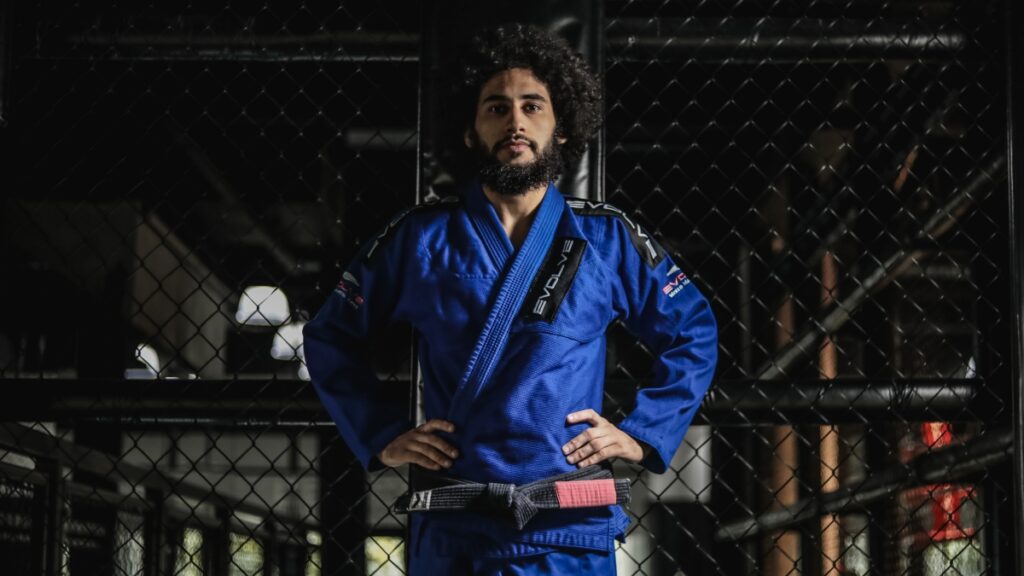Guest post by Evolve MMA, Asia’s premier championship brand for martial arts. It has the most number of World Champions on the planet. Named as the #1 ranked martial arts organization in Asia by CNN, Yahoo! Sports, FOX Sports, Evolve MMA is the best Singapore BJJ gym.
As is the case with many other martial arts, Brazilian Jiu-Jitsu (BJJ) uses a belt ranking system to indicate how far students have progressed with their training. The current BJJ ranking system looks like this:
- White
- Blue
- Purple
- Brown
- Black
It takes the average person about two years to progress between each rank. Some schools also use a stripe ranking system to determine how far a student has progressed under their current system. One, two, three, four stripes, then you’re ready to progress to the next color. Using stripes as part of a school’s ranking students gives students easier to attain milestones that indicate their hard work on the mat is paying off.
That is not the only purpose a BJJ belt serves. It also has a more practical role of keeping your gi closed while you train and roll. You’d be surprised how many BJJ students have progressed throughout the ranks without learning how to properly tie their belts.
How to tie your BJJ belt
There are many different ways to tie a BJJ belt, but we were fortunate enough to get a belt-tying lesson from World Champion BJJ black belt and One FC superstar, Leandro Issa, who shared his technique with us. Here’s how he ties his belt:
- Step 1: Fold your belt in half, making sure both ends are even
- Step 2: Close your gi, folding the left side over the right side
- Step 3: Place the middle part of the belt, right over your tummy
- Step 4: Wrap the belt around your back, passing each of its ends to the opposite hand
- Step 5: Pull at each end, so the belt is tight around your torso
- Step 6: Bring both ends to your belly button and overlap the right end with the left
- Step 7: Insert the left end underneath all layers of the belt and pull it out at the top
- Step 8: Pull at both ends of the belt to tighten it
- Step 9: Make a knot by looping the right end around the left end
- Step 10: Pull at both ends to tighten the knot
Your belt should be properly tied at this point, and it should take a lot of tugging and pulling on your gi to loosen it. Just remember, your belt only covers two inches of your backside when you spar and compete, so you’ll have to do the rest with your technique.
The history of BJJ’s belt system
Now that you know how to properly tie your BJJ belt, you’re probably wondering how belts ended up becoming the ranking system used in most martial arts. There are two main stories you might have heard. One is a false story instructors tend to prefer since it provides a richer alternative history. The real history behind BJJ’s belt ranking system isn’t as mythical.
The mythical origin of the belt system
One common story many martial arts instructors pass on to their students is that the belt system goes back thousands of years when many martial art systems were developed. According to the stories, students would start with white belts that became darker over time due to dirt, sweat, and bloodstains accumulating on them.
How discolored a student’s belt was served as an indicator of how much time they had spent on the mat. The myth claims each student’s belt first turned yellow, green, purple, dark brown, and, eventually black. Students were supposedly instructed never to wash their belts back in those days so they should display their experience level with pride.
Till today, many martial arts schools still maintain the tradition of never washing your belt. Not washing the belt also prevents any tips or merit stripes on the belt from coming off.
The made-up belt ranking history is a very good story, and it’s no surprise many in the martial arts community would prefer to pass this version of events down to their students.
The real history of martial art belt rankings
The real story of the belt ranking system used in many martial arts can be traced to a single person, Master Jigoro Kano, the founder of Judo – the style that eventually evolved into BJJ. A school teacher by trade, Kano noticed other forms of Japanese competitive arts used a ranking system, and he realized he needed something similar for the new martial art he had developed.
Before the creation of Judo and its ranking system, the Samurai used a ranking system that used five distinct levels to rank students. It was known as the Menkyo system. Each student received a certificate as they progressed through the ranks but there was nothing on their training or fighting gear that indicated their rank.
Master Kano noticed other Japanese competitors in different fields had outward displays that let people know their experience levels. For example, the more advanced Japanese swimmers of the time wore a black ribbon around their waist to indicate they were advanced swimmers.
Kano decided to create a new ranking system for his martial art that visibly displayed their rank. In 1883, Kano started differentiating between Judo practitioners by giving students white belts, while instructors or advanced pupils wore black belts.
The original belts called “obi” were a lot wider than those used today. It was designed to keep kimonos closed and to hold the swords of the Samurai. The first black belts awarded by Kano were given to his students Tomita Tsunejiro and Shiro Saigo.
Since then, martial art systems all over the world have adopted belt ranking systems and more colors have been added. Each martial art has its own belt ranking system, and many instructors and schools come up with their unique systems as well.
The main ranking system used for BJJ today goes white, blue, purple, brown, and black. Many schools break up each color with stripes or additional colors, so milestones are easier for students to reach.
Kano being a teacher probably helped him to realize how important having a ranking system was for students to build up their confidence and to mark how far they have progressed in their quest to learn Judo.

















